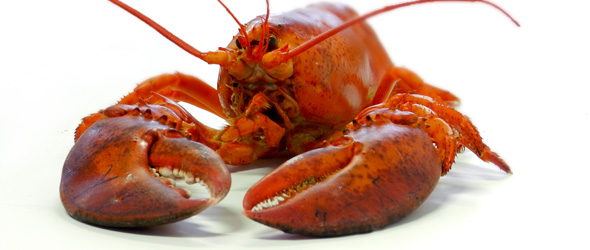Frequently Asked Questions
thanks for asking!Where do you catch your lobsters?
Most of our catch comes from the cold waters of the Gulf of Maine in the Atlantic Ocean. Lobsters mainly live in shallow water, and as they grow, they move toward the deeper water. We catch the majority of our new shell lobsters within a ten-mile radius of our Spruce Head Island facilities - the most productive lobster fishing ground in the state of Maine.
What's the difference between warm-water and cold-water lobsters?
The warm-water lobsters are the spiny or rock lobsters found in Florida, the Caribbean and southern California. The true lobster or the North American lobster can be found in the colder waters of the North Atlantic Ocean. The major difference is that the true lobster has large claws full of meat whereas the spiny lobster does not. Meat can only be extracted from the spiny lobster's tail.
A delicious Maine lobster ready to eat. Notice the large claws which are only found on lobster from the North Atlantic Ocean. Who's hungry?
What is a new shell lobster?
A lobster must shed its shell in order to grow. This process is called molting. It takes about 20 molts over 5-7 years for a lobster to become an adult. Before shedding its old shell, a paper-thin "new shell" is formed under the old shell. When the old shell is shed, the lobster is then called a new shell lobster. Some people prefer eating new shell lobsters because the meat is tender, sweet, and easy to eat. You don't need any tools to crack them apart. New shell lobsters are usually harvested from July to October.
Is there any difference in taste between male and female lobsters?
Except for minor physiological differences, the male and female lobster are very much the same. The female lobsters may sometimes have roe (eggs) inside the body cavity, which turn bright red upon cooking. Restaurant chefs occasionally request female lobsters from us for the roe to be used in presentation.
What is the largest lobster Atwood has ever shipped?
The largest lobster ever shipped was 25" to 30" long and approximately 27 pounds. It was caught in Canada (where oversized restrictions weren't in place). Picture the width of a kid's lunchbox - which was the width of that lobster. The Palms Restaurant in NYC wanted it.
Do you ever catch blue lobsters?
Blue lobsters are rare, as the pigments in their shells are genetic defects. Most lobsters are greenish-brown in color, but we've seen blue, bright red (almost the same color as cooked) and even part-white lobsters.
Do lobsters feel pain?
Like all arthropods, the nervous system of a lobster is very primitive, and contains far fewer nerve cells than our nervous systems. The nerve cells are grouped in clusters called ganglia. Further, a lobster has no cerebral cortex, the area of the human brain that gives the perception of pain.
How long can a lobster survive out of water?
Lobsters have special gills that allow them to survive out of water. If they are kept cool and damp, lobsters could probably survive out of water up to a week - but we wouldn't recommend eating them!
Are lobsters low in cholesterol?
Yes. In 1990, The National Institutes of Health tested lobster for cholesterol content and found that it was just as low in cholesterol, fat and calories as chicken and turkey. (Just watch out for the drawn butter!)
3.5 ounce portion| Cholesterol | Calories | Saturated Fat | |
| Lobster | 72 mg | 98 | 0.1g |
| Skinless Chicken | 85 mg | 173 | 1.3g |
| Skinless turkey | 86 mg | 140 | 0.4g |
*Courtesy of the Maine Lobster Promotion Council
Should I eat the green stuff?
Though the tomalley (the light green substance found in the lobster's body) is a delicacy for some, the Maine Lobster Promotion Council advises against eating it. As the tomalley is the liver and pancreas of the lobster, contaminants such as dioxins might have entered the system from the environment.



